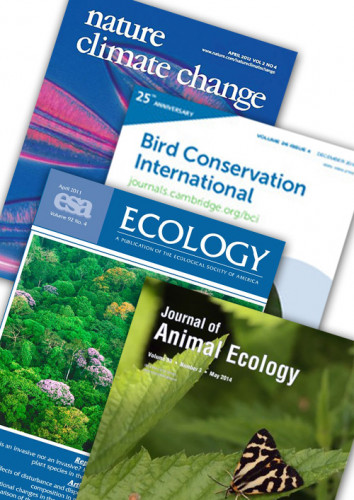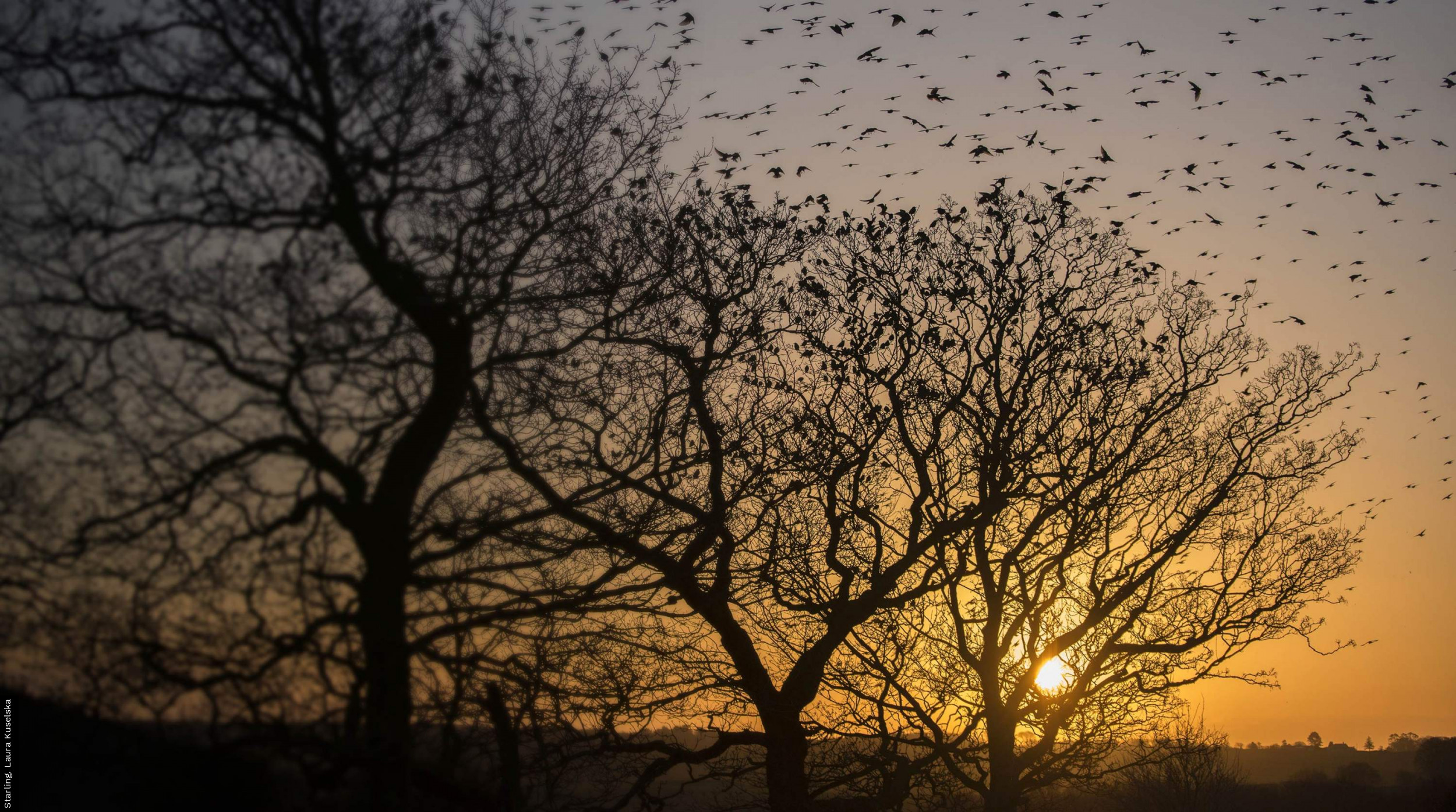Peer-reviewed papers

It is BTO’s policy to make public the results of our research. Our aim is to publish as much as possible of our work in the peer reviewed scientific literature. Many results are also published in our BTO Research Report series.
2015.
Organic Farming: Biodiversity Impacts Can Depend on Dispersal Characteristics and Landscape Context.
PLOS ONE
10 (part 8)
Link to Article (DOI: 10.1371/journal.pone.0135921)
2015.
Multi-scale associations with habitat, land use and change: Opportunities and limitations for Whinchats Saxicola rubetra in the uplands of Scotland.
Book title: Living on the edge of extinction in Europe. Proceedings of the first European Whinchat Symposium
: 205-212
2015.
Light-level geolocators reveal migratory connectivity in European populations of pied flycatchers Ficedula hypoleuca.
Journal of Avian Biology
View Abstract
Link to Article (DOI: 10.1111/jav.00721)
2015.
Managing Conflict between Bats and Humans: The Response of Soprano Pipistrelles (Pipistrellus pygmaeus) to Exclusion from Roosts in Houses.
PLOS ONE
10 (part 8)
View Abstract
Link to Article (DOI: 10.1371/journal.pone.0131825)
2015.
Hydrologically driven ecosystem processes determine the distribution and persistence of ecosystem-specialist predators under climate change
.
Nature Communications
6
View Abstract
Link to Article (DOI: 10.1038/ncomms8851)
2015.
Swedish birds are tracking temperature but not rainfall: evidence from a decade of abundance changes.
Global Ecology and Biogeography
24
: 859-872
Link to Article (DOI: 10.1111/geb.12308)
2015.
Geographical range margins of many taxonomic groups continue to shift polewards.
Biological Journal of the Linnean Society
115 (part 3)
: 586-597
View Abstract
Link to Article (DOI: 10.1111/bij.12574)
2015.
Breeding season habitat associations and population declines of British Hawfinches Coccothraustes coccothraustes.
Bird Study
62 (part 3)
: 348-357
View Abstract
Link to Article (DOI: 10.1080/00063657.2015.1046368)
2015.
A novel citizen science approach for large-scale standardised monitoring of bat activity and distribution, evaluated in eastern England.
Biological Conservation
191
: 38-49
View Abstract
Link to Article (DOI: 10.1016/j.biocon.2015.06.009)
2015.
Ecosystem recharge by volcanic dust drives broad-scale variation in bird abundance.
Ecology and Evolution
5 (part 12)
: 2 386-2 396
View Abstract
Link to Article (DOI: 10.1002/ece3.1523)
2015.
Time-in-area represents foraging activity in a wide-ranging pelagic forager.
Marine Ecology Progress Series
527
: 233-246
View Abstract
Link to Article (DOI: 10.3354/meps11262)
2015.
A method to evaluate the combined effect of tree species composition and woodland structure on indicator birds.
Ecological Indicators
55
: 44-51
Link to Article (DOI: 10.1016/j.ecolind.2015.03.007)
2015.
The contribution of volunteer recorders to our understanding of biological invasions.
Biological Journal of the Linnean Society
115 (part 3)
: 678-689
View Abstract
Link to Article (DOI: 10.1111/bij.12518)
2015.
Differential migration of chiffchaffs (Phylloscopus collybita and Phylloscopus ibericus) in Europe and Africa.
Journal of Avian Biology
36
: 184-190
Link to Article (DOI: 10.13157/arla.62.2.2015.237)
2015.
Seabird–wind farm interactions during the breeding season vary within and between years: A case study of lesser black-backed gull Larus fuscus in the UK.
Biological Conservation
186 (part 2 015)
: 347-358
View Abstract
Link to Article (DOI: 10.1016/j.biocon.2015.03.027)
2015.
Climate change and Britain's wildlife: what might we expect?.
British Wildlife
26 (part 3)
: 161-174
2015.
Quantifying the risk of introduction of West Nile Virus into Great Britain by migrating passerine birds.
Transboundary and Emerging Diseases
View Abstract
Link to Article (DOI: 10.1111/tbed.12310)
2015.
The impact of changing habitat availability on population trends of woodland birds associated with early successional plantation woodland.
Bird Study
62 (part 1)
: 39-55
View Abstract
Link to Article (DOI: 10.1080/00063657.2014.998622)
2015.
Comparison of breeding bird assemblages in conifer plantations managed by continuous cover forestry and clearfelling.
Forest Ecology and Management
344
: 20-29
View Abstract
Link to Article (DOI: 10.1016/j.foreco.2015.02.017)
2015.
A method of making robust and effective decoys for trapping waders using dead birds.
Wader Study Group Bulletin
122 (part 1)
: 31-36
View Abstract
Link to Article (DOI: 10.18194/ws.00008)
2015.
Latitudinal gradients in the productivity of European migrant warblers have not shifted northwards during a period of climate change.
Global Ecology and Biogeography
24
: 427-436
View Abstract
Link to Article (DOI: 10.1111/geb.12267)
2015.
A pan-European, multipopulation assessment of migratory connectivity in a near-threatened migrant bird.
Diversity and Distributions
View Abstract
Link to Article (DOI: 10.1111/ddi.12345)
2015.
The effectiveness of protected areas in the conservation of species with changing geographical ranges.
Biological Journal of the Linnean Society
115 (part 3)
: 707-717
View Abstract
Link to Article (DOI: 10.1111/bij.12506)
2015.
Directionality of recent bird distribution shifts and climate change in Great Britain.
Global Change Biology
21
: 2 155-2 168
View Abstract
Link to Article (DOI: 10.1111/gcb.12823)
2015.
Modelling the abundance and distribution of marine birds accounting for uncertain species identification.
Journal of Applied Ecology
52 (part 1)
: 150-160
View Abstract
Link to Article (DOI: 10.1111/1365-2664.12364)
2015.
Multi-species spatially-explicit indicators reveal spatially structured trends in bird communities.
Ecological Indicators
58
Elsevier
: 277-285
Link to Article (DOI: 10.1016/j.ecolind.2015.06.001)
2015.
Flexibility in the timing of post-breeding moult in passerines in the UK.
Ibis
157 (part 2)
: 340-350
Link to Article (DOI: 10.1111/ibi.12234)
2015.
Season-long consequences of shifts in timing of breeding for productivity in Willow Warblers, Phylloscopus trochilus.
Bird Study
62 (part 2)
: 161-169
View Abstract
Link to Article (DOI: 10.1080/00063657.2015.1006575)
2015.
Climate-driven changes in winter abundance of a migratory waterbird in relation to EU protected areas.
Diversity and Distributions
21 (part 5)
: 571-582
View Abstract
Link to Article (DOI: 10.1111/ddi.12300)
2015.
Drivers of climate change impacts on bird communities.
Journal of Animal Ecology
84 (part 4)
British Ecological Society
: 943-954
Link to Article (DOI: 10.1111/1365-2656.12364)
2015.
Developing and enhancing biodiversity monitoring programmes: a collaborative assessment of priorities.
Journal of Applied Ecology
52 (part 3)
: 686-695
View Abstract
Link to Article (DOI: 10.1111/1365-2664.12423)
2015.
Raptors in Scotland – a methodology for developing trends and indicators.
SNH Commissioned Report
542
Scottish Natural Heritage
2015.
Hatching success in Lesser Black-backed Gulls Larus fuscus - an island case study of the effects of egg and nest site quality.
Seabirds
28
: 1-16
2015.
Climate-induced changes in river flow regimes will alter future bird distributions.
Ecosphere
6
View Abstract
Link to Article (DOI: 10.1890/ES14-00245.1)
2015.
Home-range size and habitat use of European Nightjars Caprimulgus europaeus nesting in a complex plantation-forest landscape.
Ibis
157 (part 2)
: 260-272
View Abstract
Link to Article (DOI: 10.1111/ibi.12251)
2015.
Evidence for the buffer effect operating in multiple species at a national scale.
Biology Letters
11 (part 1)
View Abstract
Link to Article (DOI: 10.1098/rsbl.2014.0930)
2015.
Bayesian hierarchical modelling of continuous non-negative longitudinal data with a spike at zero: An application to a study of birds visiting gardens in winter.
Biometrical Journal
View Abstract
Link to Article (DOI: 10.1002/bimj.201400081)
2014.
Comparison of trends in butterfly populations between monitoring schemes.
Journal of Insect Conservation
19 (part 2)
: 313-324
Link to Article (DOI: 10.1007/s10841-014-9739-0)
2014.
A global assessment of the conservation status of the nominate subspecies of Eurasian oystercatcher (Haematopus ostralegus ostralegus).
International Wader Studies
20
: 47-61
View Abstract
2014.
Can management improve the value of shade plantations for the endemic species of São Tomé Island?.
Biotropica
46
: 238-244
View Abstract
Link to Article (DOI: 10.1111/btp.12092)
2014.
Modelling the Progression of Bird Migration with Conditional Autoregressive Models Applied to Ringing Data.
PLOS ONE
9 (part 7)
Link to Article (DOI: 10.1371/journal.pone.0102440)
2014.
Defining the key wintering habitats in the Sahel for declining African-Eurasian migrants using expert assessment.
Bird Conservation International
24 (part 4)
: 477-491
View Abstract
Link to Article (DOI: 10.1017/S0959270913000531)
2014.
Grazing and moorland birds.
Book title: Ecology and conservation of birds in upland and alpine habitats: Proceedings of the BOU Annual Conference held at the University of Leicester, 1-3 April 2014
BOU
View Abstract
2014.
Conservation management of moorland: a case study of the effectiveness of a combined suite of management prescriptions which aim to enhance breeding bird populations.
Bird Study
61 (part 1)
: 56-72
View Abstract
Link to Article (DOI: 10.1080/00063657.2013.876615)
2014.
Changes in breeding wader assemblages, vegetation and land use within machair environments over three decades.
Bird Study
61 (part 3)
: 287-300
View Abstract
Link to Article (DOI: 10.1080/00063657.2014.917604)
2014.
Impacts of drainage and climate change on keystone insects and upland breeding birds.
Book title: Ecology and conservation of birds in upland and alpine habitats: Proceedings of the BOU Annual Conference held at the University of Leicester, 1-3 April 2014
BOU
View Abstract
2014.
Saving the Spoon-billed Sandpiper: an update on the conservation programme.
British Birds
107
: 467-475
2014.
Indicators of seabird reproductive performance demonstrate the impact of commercial fisheries on seabird populations in the North Sea.
Ecological Indicators
38
: 1-11
View Abstract
Link to Article (DOI: 10.1016/j.ecolind.2013.10.027)
2014.
Generating population estimates for common and widespread breeding birds in Ireland.
Bird Study
61 (part 1)
: 82-90
View Abstract
Link to Article (DOI: 10.1080/00063657.2013.868401)



Share this page